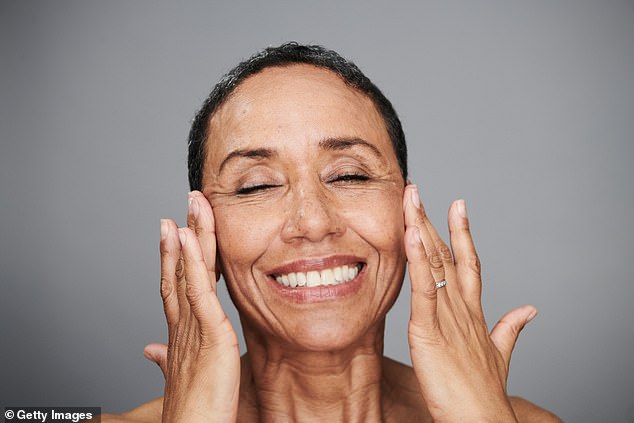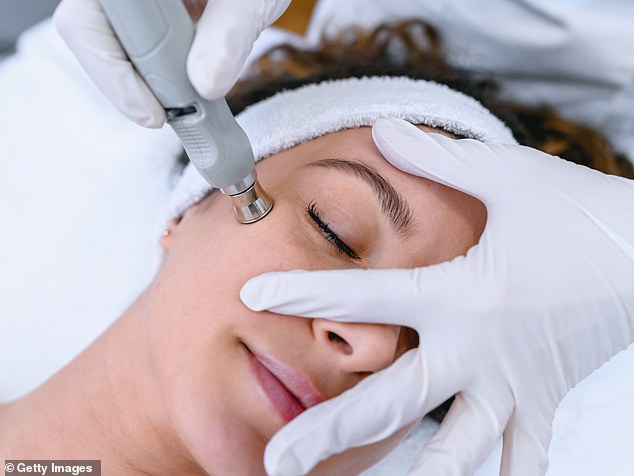Daily Mail journalists select and curate the products that feature on our site. If you make a purchase via links on this page we will earn commission – learn more
You would think a good night’s sleep would be an easy fix for dark under-eye circles, but the truth is some of us are constantly plagued by them.
Those stubborn blue or purple rings can crop up under our eyes for various reasons – genetics, ageing and allergies included – and getting rid of them is not so simple.
While dark circles are ‘completely normal given the busy and hectic lives we all lead’, Dr Sonia Khorana, a GP and dermatology expert, tells YOU magazine, ‘removing them permanently might not be possible.’
Luckily, there are a lot of things you can do to reduce their appearance and prevent them from worsening.
Here, Dr Khorana reveals the best treatments for dark circles (both at home and in a clinic), as well as all the factors that could be contributing to the appearance of the shadowy under-eye area.
What causes dark circles?
Dark circles are shadows around your eyes that appear darker.
According to Dr Khorana, there are several factors to consider, including genetics, ageing and fatigue. ‘People often think dark circles are due to tiredness and a lack of sleep,’ she explains, ‘but sometimes you could be racking up a full eight hours of sleep a night and it wouldn’t make any difference.’
Lifestyle
Sleepless nights, prolonged screen time, smoking and high alcohol intake, coupled with the fact that the skin around our eyes is so thin and delicate, can be the perfect recipe for those pesky under-eye circles.
Allergies
This area is very sensitive and chronic rubbing due to irritation from seasonal allergies or eczema can exacerbate inflammatory pigmentation. Taking antihistamines may help in this situation.
Genetics
Dark circles can simply be inherited. If you’ve had them your whole life, they’re probably genetic and there to stay.

Genetics, ageing and allergies can cause dark circles
Sensitive skin
The skin around the eyes is significantly thinner and more delicate than any other area of the body. Superficial vessels can show through the translucent skin more easily, further contributing to the appearance of dark shadows.
Skin colour
Darker-skinned individuals are more prone to having hyperpigmentation under the eyes due the melanin in their skin. This along with sun exposure can make the skin under your eyes appear even darker.
Ageing
Natural ageing is also a big culprit, as shadowing from sagging, dehydrated skin and lost facial volume results in the appearance of dark circles.
How to get rid of dark circles at home
Use an eye cream
‘When you’re looking for eye creams to help treat your dark circles, it is important to look for brightening treatments containing tried and tested ingredients,’ says Dr Khorana.
You’ll experience good results with formulas featuring retinoids, vitamin c, kojic acid, liquorice root extract, niacinamide and azelaic acid. Caffeine in eye creams can also help to reduce puffiness.
Get eight hours of sleep
We all know that sleep has great benefits for your skin. ‘There’s a reason it’s often referred to as beauty sleep. It is necessary for the maintenance of collagen and cell regeneration.’
For best results, follow Dr Khorana’s advice and try to get about eight hours of shut eye.
Always wear SPF
‘Sun exposure can make your dark circles worse,’ Dr Khorana explains. ‘I can’t stress how important it is to use an SPF to protect the delicate skin around your eyes.’
Maintain a healthy diet
While there aren’t any quick fixes for dark circles, Dr Khorana recommends maintaining a nutritious diet full of fresh fruits, vegetables, whole grains, lean protein and healthy fats as ‘these can benefit your skin overall and lead to some improvements in the under-eye area’.
Be gentle with make-up removal
Rubbing your eyes can contribute to the appearance of dark circles, so be gentle when you’re removing your make-up.
Dr Khorana’s advice? Use a gentle cleanser, lukewarm water and avoid excessive rubbing or scrubbing.
Don’t over-cleanse as it can dry out your skin, and avoid make-up wipes as they’re often harsh and can cause friction and dryness.
Reach for a cold compress
A cold compress can reduce the appearance of dark circles by narrowing the dilated blood vessels.
‘Ice can help with this, but I wouldn’t recommend putting it directly on your skin,’ says Dr Khorana. ‘You can invest in cryo globes or ice rollers, or keep some spoons in the fridge.’ A cold tea compress will work in the same way as it will vasoconstrict vessels.
How to get rid of dark circles professionally
If your dark circles are caused by medical conditions, ageing and the structure of your face, they can be much trickier to treat and there’s not much that can be achieved by using creams and compresses.
However, there are some in-clinic treatments that can help with reducing their appearance.
Laser treatments
Depending on the cause, Dr Khorana says there are some laser treatments that can help to address excess melanin causing pigmentation and promote collagen production resulting in brighter looking eyes.

Some laser treatments can address dark circles
Chemical peels
Chemical peels are often the go-to treatment for treating hyperpigmentation. ‘Milder peels containing mandelic, glycolic and lactic acid are recommended as deep peels can further damage the delicate skin,’ Dr Khorana notes. ‘This can be combined with micro needling, which intensifies the effect of the peel.’
Dermal fillers
Injectables such as tear trough dermal fillers are a very popular non-surgical treatment option because they ‘can help replace volume to the hollowed areas around the eyes responsible for creating the dark shadows’.
This can result in a fresher appearance. Dr Khorana stresses this treatment isn’t for everyone, ‘so you need to see someone experienced who can assess whether this may be the right treatment for you.’
Non-traditional dermal fillers
Per Dr Khorana, injectables like polynucleotides and sunekos are also effective. ‘They help with collagen stimulation, which can help thicken the dermis and reduce the appearance of dark circles.’ Results are gradual and over time.
Blepharoplasty
For individuals with hooded eyelids or eyebags that further aggravate the appearance of dark circles, Dr Khorana says ‘a cosmetic surgery procedure known as blepharoplasty can be considered.’
What’s the difference between dark circles and under-eye bags?
While dark circles and under-eye bags are both common skin concerns, there is a difference.
Dr Khorana says under-eye bags can occur for a number of reasons, including fluid retention (from salty food, sleep position, allergies, medical conditions), fat pads shifting with age, skin laxity (natural collagen loss over time) and chronic rubbing or irritation.











